
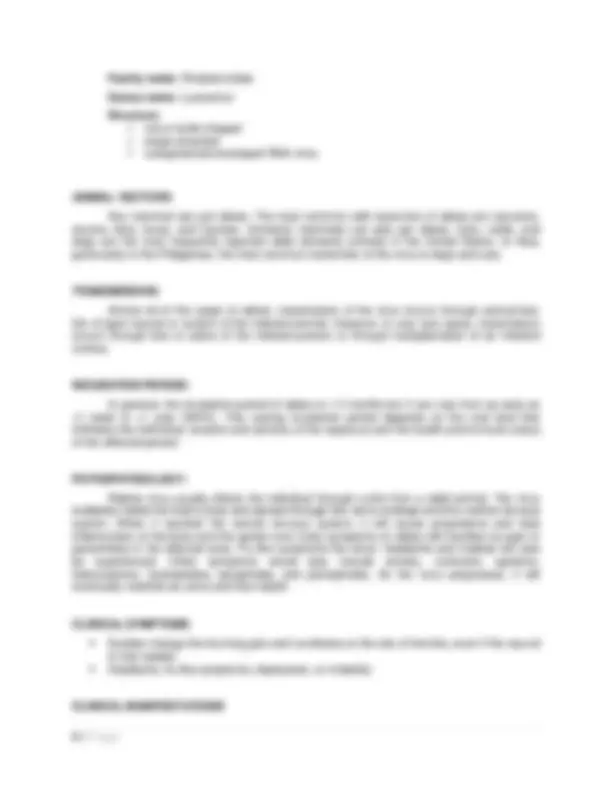
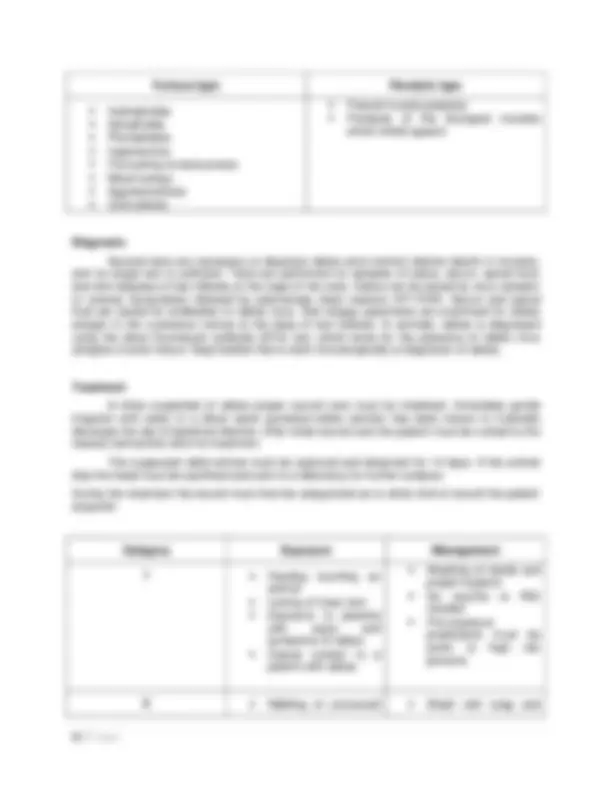
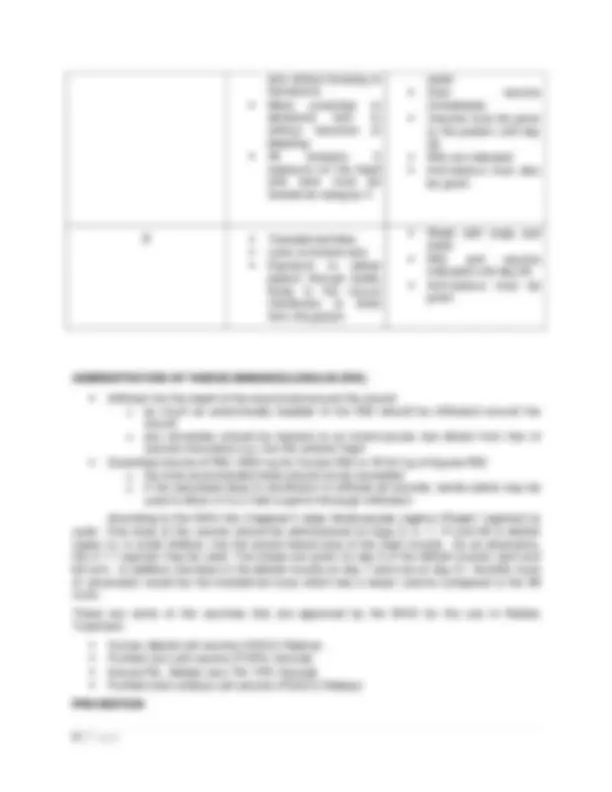
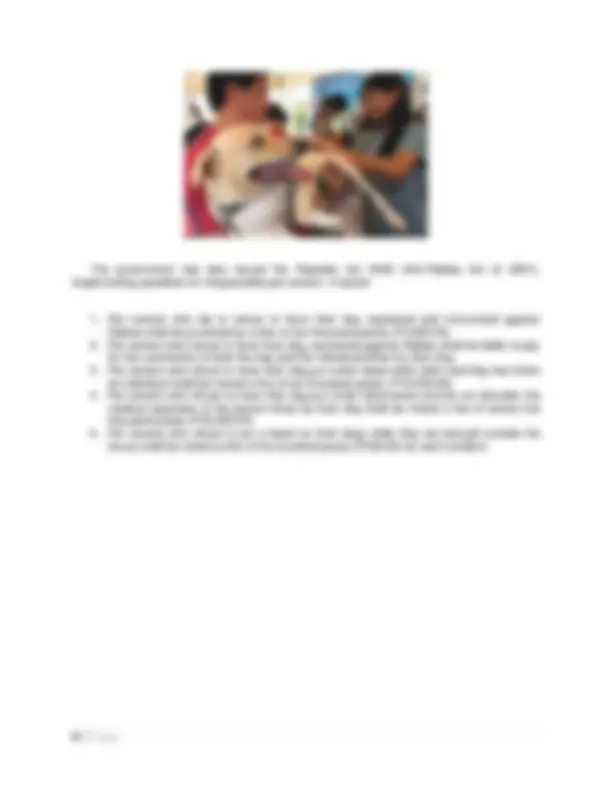
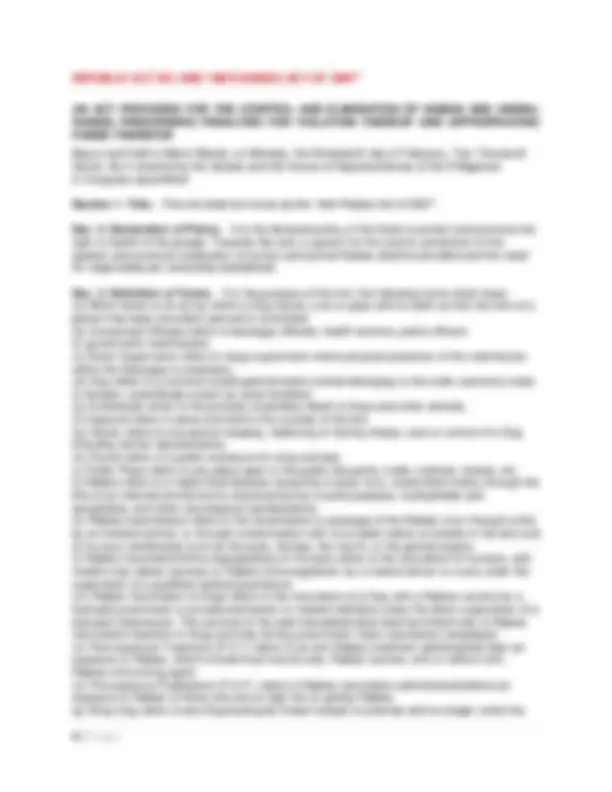
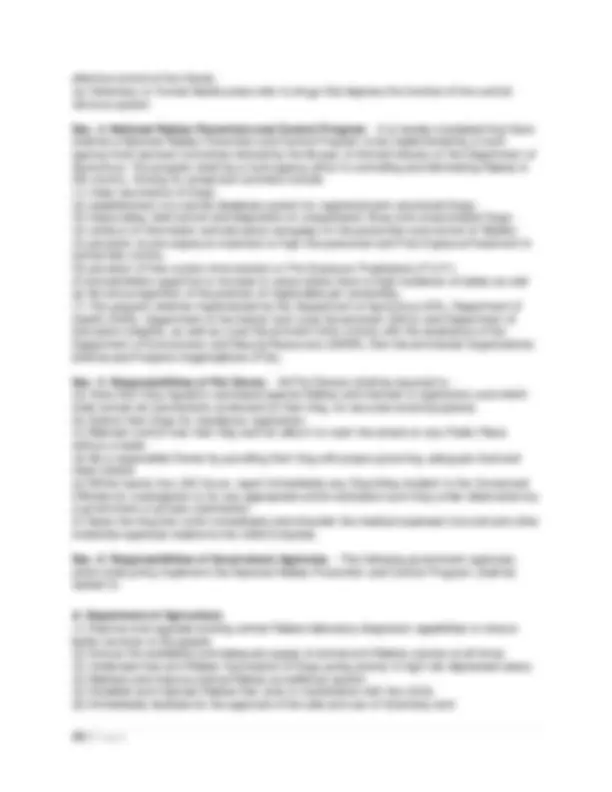
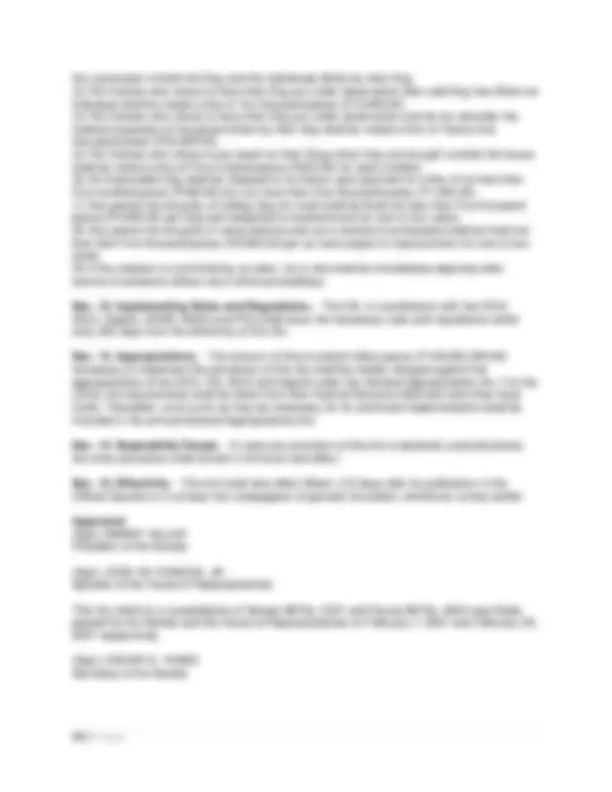



Study with the several resources on Docsity

Earn points by helping other students or get them with a premium plan


Prepare for your exams
Study with the several resources on Docsity

Earn points to download
Earn points by helping other students or get them with a premium plan
Community
Ask the community for help and clear up your study doubts
Discover the best universities in your country according to Docsity users
Free resources
Download our free guides on studying techniques, anxiety management strategies, and thesis advice from Docsity tutors
Rabies report for comminity mediociner
Typology: Lecture notes
1 / 14

This page cannot be seen from the preview
Don't miss anything!









Submitted by: ACDAL, Strawberry ALCANTARA, John Clemen ALDECOA, Aileen Dorothy TRESPUER, Dianna Jean UBALDO, Anna Victoria
August 7, 2015
Each year around the world, rabies results in more than 55,000 deaths – approximately 1 death every 10 minutes. Most deaths are reported from Africa (43.6%) and Asia (56%) with almost 50% of the victims being children under the age of 15 years old. (Based on Center for Disease Control and Prevention)
PHILIPPINES (2011 Rabies and Bite Victim Annual Report) It is responsible for 200-250 death among Filipinos From year 2007-2011 there is a decline of 23% in cases of human infected with Rabies
Region 5 have the highest prevalence of Rabies of about 12%
Male in predominance Dogs are still the most leading cause of rabies
Latin word: rabies which means “madness” First incident was in Mesopotamia since 2000 BC 19 th^ century there was high prevalence of rabies
Furious type Paralytic type
Hydrophobia Aerophobia Photophobia Hyperactivity Fluctuating consciousness Mood swings Aggressiveness Convulsions
Flaccid muscle paralysis Paralysis of the laryngeal muscles which inhibit speech
Diagnosis
Several tests are necessary to diagnose rabies ante-mortem (before death) in humans, and no single test is sufficient. Tests are performed on samples of saliva, serum, spinal fluid, and skin biopsies of hair follicles at the nape of the neck. Saliva can be tested by virus isolation or reverse transcription followed by polymerase chain reaction (RT-PCR). Serum and spinal fluid are tested for antibodies to rabies virus. Skin biopsy specimens are examined for rabies antigen in the cutaneous nerves at the base of hair follicles. In animals, rabies is diagnosed using the direct fluorescent antibody (DFA) test, which looks for the presence of rabies virus antigens in brain tissue. Negri bodies that is seen microscopically is diagnostic of rabies.
Treatment
In bites suspected of rabies proper wound care must be initialized. Immediate gentle irrigation with water or a dilute water povidone-iodine solution has been shown to markedly decrease the risk of bacterial infection. After initial wound care the patient must be rushed to the nearest animal bite clinic for treatment.
The suspected rabid animal must be captured and observed for 14 days. If the animal dies the head must be sacrificed and sent to a laboratory for further analysis.
During the treatment the wound must then be categorized as to white kind of wound the patient acquired.
Category Exposure Management
(^1) Feeding touching an animal Licking of intact skin Exposure to patients with signs and symptoms of rabies Casual contact to a patient with rabies
Washing of hands and proper hygiene No vaccine or RIG needed Pre-exposure prophylaxis must be given to high risk persons
(^2) Nibbling of uncovered Wash with soap and
skin without bruising or hematoma Minor scratches or abrasions with or without induction of bleeding All category 2 exposure on the head and neck must be treated as category 3
water Start vaccine immediately Vaccine must be given to the patient until day 28 RIG not indicated Anti-tetanus must also be given
(^3) Transdermal bites Licks on broken skin Exposure to rabies patient through bodily fluids in the mucus membrane or bites from the patient
Wash with soap and water RIG and vaccine indicated until day 28 Anti-tetanus must be given
Infiltrate into the depth of the wound and around the wound o as much as anatomically feasible of the RIG should be infiltrated around the wound o any remainder should be injected at an intramuscular site distant from that of vaccine inoculation e.g. into the anterior thigh Quantities/volume of RIG: 20IU/ kg for Human RIG or 40 IU/ kg of Equine RIG o the total recommended dose should not be exceeded o if the calculated dose is insufficient to infiltrate all wounds, sterile saline may be used to dilute it 2 to 3 fold to permit thorough infiltration According to the WHO the Classical 5 dose intramuscular regime (“Essen” regimen) is used. One dose of the vaccine should be administered on days 0, 3, 7, 14 and 28 in deltoid region or, in small children, into the antero-lateral area of the thigh muscle. As an alternative, the 2-1-1 regimen may be used. Two doses are given on day 0 in the deltoid muscle, right and left arm. In addition one dose in the deltoid muscle on day 7 and one on day 21. Another route of vaccination would be the intradermal route which has a lesser volume compared to the IM route.
These are some of the vaccines that are approved by the WHO for the use in Rabies Treatment:
Human diploid cell vaccine (HDCV) Rabivac Purified vero cell vaccine (PVRV) Verorab ImovaxTM , Rabies vero TM, TRC Verorab Purified chick embryo cell vaccine (PCECV) Rabipur
PREVENTION
In accordance with RA 9482 or “The Rabies Act of 2007”, rabies control ordinances shall be strictly implemented. In the same manner, the public shall be informed on the proper management of animal bites and/or rabies exposures.
To attain their goal, the Department of Health is in partnership with other government agencies and organizations, namely:
Department of Agriculture (DA) Department of Education (DepEd) Department of Interior and Local Government (DILG) World Health Organization (WHO) Animal Welfare Coalition (AWC) BMGF Foundation WHO/BMGF Rabies Elimination Project
One of their means of educating the community is by distributing brochures and posting posters about Rabies. They encourage the people to prevent Rabies by being a responsible pet owner by:
The government has also issued the Republic Act 9482 (Anti-Rabies Act of 2007), implementing penalties for irresponsible pet owners. It stated:
effective control of the Owner. (q) Veterinary or Human Barbiturates refer to drugs that depress the function of the central nervous system.
Sec. 4. National Rabies Prevention and Control Program. - It is hereby mandated that there shall be a National Rabies Prevention and Control Program to be implemented by a multi- agency/multi-sectoral committee chaired by the Bureau of Animal Industry of the Department of Agriculture. The program shall be a multi-agency effort in controlling and eliminating Rabies in the country. Among its component activities include: (1) mass vaccination of Dogs; (2) establishment of a central database system for registered and vaccinated Dogs; (3) impounding, field control and disposition of unregistered, Stray and unvaccinated Dogs; (4) conduct of information and education campaign on the prevention and control of Rabies; (5) provision on pre-exposure treatment to high risk personnel and Post ExposureTreatment to animal bite victims; (6) provision of free routine immunization or Pre-Exposure Prophylaxis (P.E.P.) of schoolchildren aged five to fourteen in areas where there is high incidence of rabies as well as the encouragement of the practice of responsible pet ownership; (7) The program shall be implemented by the Department of Agriculture (DA), Department of Health (DOH), Department of the Interior and Local Government (DILG) and Department of Education (DepEd), as well as Local Government Units (LGUs) with the assistance of the Department of Environment and Natural Resources (DENR), Non-Governmental Organizations (NGOs) and People’s Organizations (POs).
Sec. 5. Responsibilities of Pet Owner. - All Pet Owners shall be required to: (a) Have their Dog regularly vaccinated against Rabies and maintain a registration card which shall contain all vaccinations conducted on their Dog, for accurate record purposes. (b) Submit their Dogs for mandatory registration. (c) Maintain control over their Dog and not allow it to roam the streets or any Public Place without a leash. (d) Be a responsible Owner by providing their Dog with proper grooming, adequate food and clean shelter. (e) Within twenty-four (24) hours, report immediately any Dog biting incident to the Concerned Officials for investigation or for any appropriate action and place such Dog under observation by a government or private veterinarian. (f) Assist the Dog bite victim immediately and shoulder the medical expenses incurred and other incidental expenses relative to the victim’s injuries.
Sec. 6. Responsibilities of Government Agencies. - The following government agencies, which shall jointly implement the National Rabies Prevention and Control Program, shall be tasked to:
A. Department of Agriculture (1) Improve and upgrade existing animal Rabies laboratory diagnostic capabilities to ensure better services to the people. (2) Ensure the availability and adequate supply of animal anti-Rabies vaccine at all times. (3) Undertake free anti-Rabies Vaccination of Dogs giving priority to high risk depressed areas. (4) Maintain and improve animal Rabies surveillance system. (5) Establish and maintain Rabies free zone in coordination with the LGUs. (6) Immediately facilitate for the approval of the sale and use of Veterinary and
Human Barbiturate drugs and veterinary euthanasia drugs by the DOH and the Philippine Drug Enforcement Agency (PDEA). (7) Strengthen the training of field personnel and the Information Education and Communication (IEC) activities on Rabies prevention and control and responsiblepet ownership. (8) Conduct research on Rabies and its control in coordination with other agencies. (9) Formulate minimum standards and monitor the effective implementation of this Act. (10) Encourage collaborative activities with the DOH, DepEd, DILG, DENR, NGOs, POs and other concerned sectors.
B. Department of Health (1) Ensure the availability and adequate supply of DOH pre-qualified human AntiRabies vaccine in animal bite treatment centers at all times and shall coordinate with other implementing agencies and concerned NGOs for this purpose. (2) Provide Post-Exposure Treatment at the minimum expense to individuals bitten by animals suspected of being rabid which will consist of the initial vaccine and immunoglobulin dose. (3) Provide Pre-Exposure Treatment to high-risk personnel, such as, but not limited to, laboratory staff,veterinarians, animal handlers, vaccinators and other persons working with Rabies virus for free. (4) Coordinate with the DA in the development of appropriate health education strategy to inform the public on Rabies prevention and control and responsible pet ownership. (5) Develop and maintain a human Rabies surveillance system.(6) Encourage collaborative activities with the DA, DepEd, DILG, DENR, NGOs, POs and other concerned sectors. (7) Immediately approve the registration of Veterinary and Human Barbiturate drugs and veterinary euthanasia drugs in coordination with the PDEA.
C. Department of Education (1) Strengthen Rabies education program through school health teaching/curriculum. (2) Assist in the Dog mass immunization campaigns in the community. (3) Encourage collaborative activities with the DA, DOH, DILG, DENR, NGOs, POs and other concerned sectors. (4) Integrate proper information and education on responsible pet ownership in the relevant subjects in the Elementary and High School levels.
Sec. 7. Responsibilities of the LGUs. - LGUs, in their respective localities, shall: (1) Ensure that all Dogs are properly immunized, registered and issued a corresponding Dog tag for every immunized and registered Dog. (2) Strictly enforce Dog Impounding activities and field control to eliminate Stray Dogs. (3) Ensure that Dogs are leashed or confined within the premises of the Owner’s house or Owner’s fenced surroundings. (4) Allocate funds to augment the implementation of the National Rabies Prevention and Control Program, particularly on the financing of supplies and human and Dog vaccines needed for immunization. (5) Ensure the enforcement of Section 6 of Republic Act No. 8485 or “The Animal Welfare Act of 1998”. (6) Enact additional local ordinances that will support the National Rabies Prevention and Control Program that should include the regulation of treatment locally known as “tandok.” (7) Prohibit the trade of Dogs for meat. (8) With respect to cities and first class municipalities, establish and maintain a Dog Pound where Impounded Dogs shall be kept, in accordance with Section 9 herein: Provided, That the other municipalities, shall, on their own, establish a Dog Pound or opt to share the expense of
the vaccination of both the Dog and the individuals Bitten by their Dog. (3) Pet Owners who refuse to have their Dog put under observation after said Dog has Bitten an individual shall be meted a fine of Ten thousand pesos (P10,000.00). (4) Pet Owners who refuse to have their Dog put under observation and do not shoulder the medical expenses of the person bitten by their Dog shall be meted a fine of Twenty-five thousand pesos (P25,000.00). (5) Pet Owners who refuse to put leash on their Dogs when they are brought outside the house shall be meted a fine of Five hundred pesos (P500.00) for each incident. (6) An impounded Dog shall be released to its Owner upon payment of a fine of not less than Five hundred pesos (P500.00) but not more than One thousand pesos (P1,000.00). (7) Any person found guilty of trading Dog for meat shall be fined not less than Five thousand pesos,(P5,000.00) per Dog and subjected to imprisonment for one to four years. (8) Any person found guilty of using electrocution as a method of euthanasia shall be fined not less than Five thousand pesos (P5,000.00) per act and subject to imprisonment for one to four years. (9) If the violation is committed by an alien, he or she shall be immediately deported after service of sentence without any further proceedings.
Sec. 12. Implementing Rules and Regulations. - The DA, in coordination with the DOH, DILG, DepEd, DENR, NGOs and POs shall issue the necessary rules and regulations within sixty (60) days from the effectivity of this Act.
Sec. 13. Appropriations. - The amount of One hundred million pesos (P100,000,000.00) necessary to implement the provisions of this Act shall be initially charged against the appropriations of the DOH, DA, DILG and DepEd under the General Appropriations Act. For the LGUs, the requirements shall be taken from their Internal Revenue Allotment and other local funds. Thereafter, such sums as may be necessary for its continued implementation shall be included in the annual General Appropriations Act.
Sec. 14. Separability Clause. - In case any provision of this Act is declared unconstitutional, the other provisions shall remain in full force and effect.
Sec. 15. Effectivity. - This Act shall take effect fifteen (15) days after its publication in the Official Gazette or in at least two newspapers of general circulation, whichever comes earlier.
Approved: (Sgd.) MANNY VILLAR President of the Senate
(Sgd.) JOSE DE VENECIA, JR. Speaker of the House of Representatives
This Act which is a consolidation of Senate Bill No. 2541 and House Bill No. 4654 was finally passed by the Senate and the House of Representatives on February 7, 2007 and February 20, 2007 respectively.
(Sgd.) OSCAR G. YABES Secretary of the Senate
(Sgd.) ROBERTO P. NAZARENO Secretary General House of Representatives Approved: May 25, 2007
(Sgd.) GLORIA MACAPAGAL - ARROYO President of the Philippines